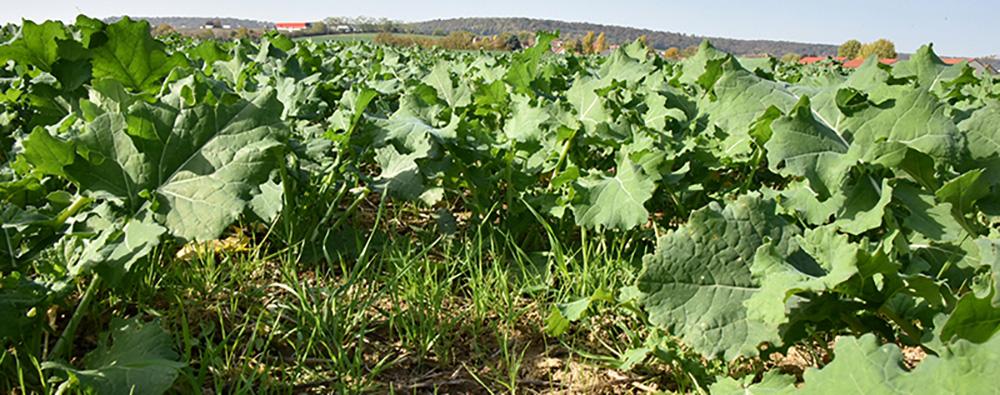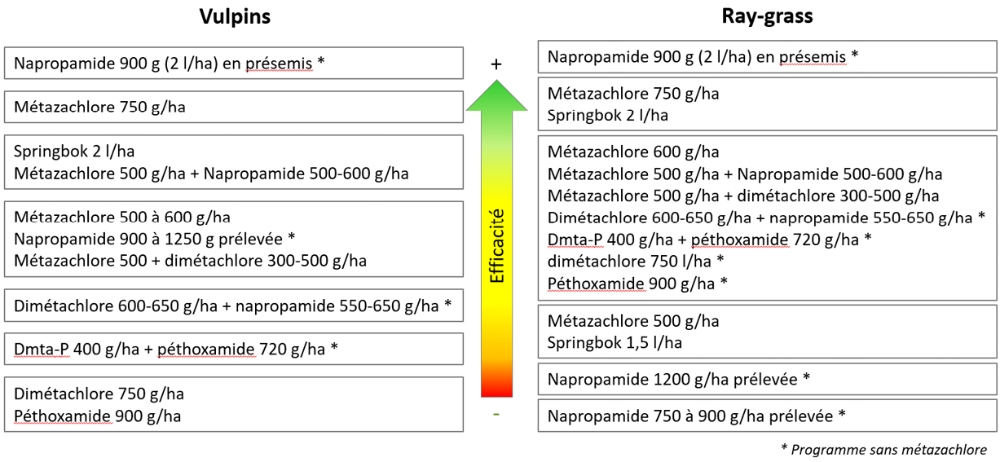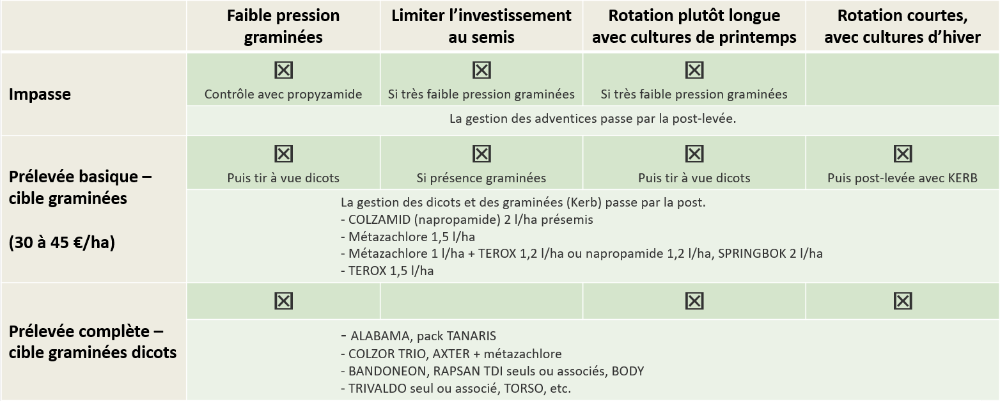The role of pre-emergence in oilseed rape herbicide programmes: managing grasses and limiting investment at seeding
The role of pre-emergence in oilseed rape herbicide programmes: managing grasses and limiting investment at seeding
Pre-emergence weed control is often unavoidable, especially in grass management, where post-emergence weed control is not always sufficient. But many questions arise. How can this intervention be more successful and what is the technico-economic optimum if one wishes to limit the investment at sowing?
Vulpine and ryegrass infestations are still increasing and are becoming a priority target in cropping systems. Heavy infestations can, at the beginning of the cycle, limit the biomass of the crop, which is necessary for the good behaviour of the plant against flea beetle larvae. In addition to all the agronomic levers known at the rotation level and unavoidable (rotation with spring crops, false seeding, occasional ploughing), it is imperative, in oilseed rape, to properly measure the technical, economic and environmental issues related to grass management".

Vulpine in oilseed rape (photo credit: L. Jung - Terres Inovia)
Less and less effective on grasses. Avoid early post-emergence against ryegrass.
The use of the MOZZAR/BELKAR speciality in post-emergence has globally solved the broadleaf problems, in particular the heavy infestations of geraniums and currants. This choice also allows us to disinvest in pre-emergence, a decision that is all the more motivated by the risk of drought which can lead to a reversal of the crop.
Dry soil conditions have led growers to opt for early post-emergence with pre-emergence products such as NOVALL or ALABAMA applied at the cotyledon to first leaf stage.
In both cases, broadleaf weed control is more effective. But just like a pre-emergence in dry conditions at the beginning of August, grass management is lacking, despite applications of propyzamide which is applied at the beginning of winter.
In fact, a deficient pre-emergence means that the graminicide action relies even more on propyzamide (KERB FLO, etc.) with potential dissatisfaction and impacts on water quality that we want to keep as limited as possible.
If early post-emergence maintains a good level of efficiency against vulpine, provided that the herbicide is based on metazachlor and that the application is carried out at the beginning of September, it is quite different against ryegrass. Indeed, this grass emerges very early, at the same time as the rape. The root and anti-germinative action of the herbicide is then lost on weeds in the process of emerging.
Foliar antigrasses are mainly used against cereal regrowth (early application around 2-4 leaves of the rape) or wild oats. The use on ryegrass and vulpine is a solution, when it still works. It must be exceptional (catching up on a failed pre-emergence) in order to prevent resistance from setting in. In this case and to reduce this risk, apply a propyzamide-based herbicide (such as KERB, IELO, etc.). Clethodim-based herbicides (CENTURION, OGIVE VXT, FOLY R, etc.) are slightly less affected by resistance.
How to manage pre-emergence in dry conditions?
It should be remembered that napropamide (COLZAMID, etc.) in pre-emergence incorporated is by far the most effective solution against vulpine and ryegrass.
In pre-emergence herbicides alone, chloroacetamides offer action against grasses: metazachlor, dimetachlor, dmta-P and pethoxamide. In pre-emergence and against vulpine, a product based on metazachlor is essential (NOVALL, ALABAMA, RAPSAN TDI, SULTAN, BANDONEON, etc.).

Summary of efficacy on vulpine and ryegrass of applications at sowing according to Terres Inovia trials
► Programme effectiveness (herbicide table) - June 2022
When soil moisture conditions are favourable to the efficacy of root herbicides (rain during the summer before application, possibly rain after application), Terres Inovia trials show that vulpine and ryegrass infestations are reduced by 50 to 80%.
On the other hand, when conditions are dry (both before and after application), efficiencies drop significantly and are between 10 and 40%. So what can be done to optimise the effectiveness of these solutions?
To control vulpine weeds, metazachlor-based pre-emergence can be applied in early post-emergence of rapeseed (rapeseed at the cotyledon stage which is starting to mark the row) and in pre-emergence of vulpine weeds, i.e. at the beginning of September. In the trials conducted by Terres Inovia in 2021 and 2022, the delay in application allows to gain 20 to 30 points of efficiency on vulpine.
To fight ryegrass that emerges at the same time as rapeseed, the situation is more delicate. The deposition of the pre-emergence to a wetter period is therefore more perilous. At best, even if the sowing is done at the beginning of August in dry conditions, we will wait for the return of the rains to apply the pre-emergence herbicide (quickly before the germination of the rape and the ryegrass). The herbicide will then be more effective and more persistent.
Reminder: regulations and water qualitySince April 2021, the conditions of use of metezachlor limit this active substance to a maximum application of 750 g/ha every 4 years or a maximum application of 500 g/ha every 3 years. The calculation is based on rapeseedings in 2021. |
Limit investment at sowing to avoid too much loss in case of reversal
Faced with uncertainties about crop establishment (late emergence and early attacks by adult flea beetles), it may be tempting to skip pre-emergence and only invest in herbicides once the success of the establishment is diagnosed (regular emergence before 5-10 September). This is very easy against broadleaf weeds, with MOZZAR in post-emergence in particular. However, it is not advisable to do this on medium or high grass pressure. It is therefore necessary to maintain a pre-emergence application but it is possible to optimise its application. As previously mentioned, early post-emergence is only feasible for vulpine control.
Limiting the investment at sowing means choosing a very basic pre-emergence herbicide (or COLZAMID as a pre-seed incorporated) which remains optimal for grass control. Solutions based on metazachlor (SULTAN, RAPSAN, SPRINGBOK) or dimetachlor (TEROX, COLZOR UNO) are preferred on ryegrass. On vulpine, it is preferable to stay with metazachlor-based solutions. The cost will then be between 30 and 45 €/ha. The rest of the investment will be made after successful establishment, against cereal regrowth, broadleaf weeds or to "finish" grass control with propyzamide (KERB FLO, etc.)
The different strategies are summarised in the table below.
Maintaining good propyzamide efficacy conditions
This year, many dissatisfactions on the efficacy of propyzamide were reported. The first question raised was that of resistance. But in fact, no populations of vulpine or ryegrass resistant to propyzamide have been discovered in field crops. The monitoring carried out by the companies also points in this direction. Efficiency defects are most often explained by more numerous and more developed populations (dense root system, deep rooting) at the time of propyzamide application at the beginning of winter.
To optimize the efficiency of the active substance, the application must be done in wet and cool soil conditions (soil temperature < 10°C) in November (preferable) or December at the most, and on weeds that are not very developed. It is preferable to avoid applications before heavy rainfall to limit the impact on water quality. Finally, you must be patient because the effectiveness of propyzamide is a long run. Efficacy is judged 3 months after application. For regulatory reasons, as well as for water quality reasons, a single application is the basic rule
Regulatory reminderIn its technical instruction of 27 May 2021 "Controller's guide", the DGAL wrote the following instruction: "The dose and maximum number of applications apply to all commercial specialities whose composition is strictly identical. Except in special cases (), this cumulative use of PPPs containing the same active substance leads to the maximum authorised application rate being exceeded and is therefore not permitted. " |
In addition
► Metazachlor: regulations and impact on oilseed rape weed control
► Oilseed rape results - Effectiveness of pre-emergence herbicides against ryegrass and vulpine grass
| |
Franck Duroueix, Aurore Baillet, Jean Lieven, Clément Munier - Terres Inovia